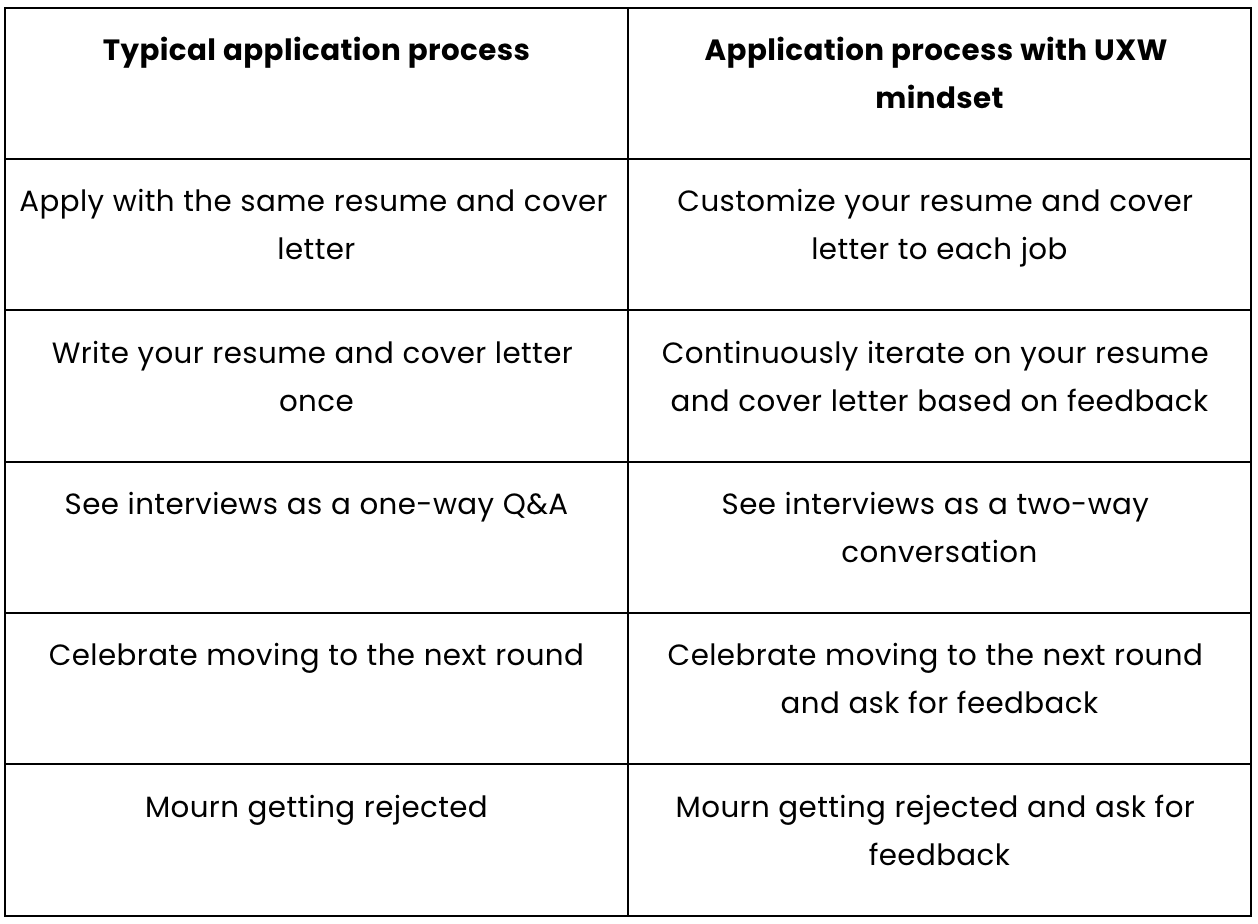UX writing and content design are hot jobs nowadays.
The field is exploding, and everyone from education to technical writing is looking to change their LinkedIn headline to “UX Writer | Content Designer” and officially become a UX writer.
If this is you, which I’m guessing it is, because you clicked on this article, you’re probably wondering what kinda challenge you’re up against. Aka, is it hard to land a UX writing job?
Landing a UX writing job can be hard, but it’s 10x easier if you approach it with the UX writing mindset.
Most people approach applying for jobs the same way — you make a resume and cover letter, maybe a portfolio, apply, interview, and keep chugging along until you get an offer.
The UX writing mindset is a bit different. It involves:
- Experimentation and iteration
- Putting yourself in the user’s shoes
- Experience design
- Utilizing UX research and insights
Just like a UX writer or content designer would do on a typical project for digital products.
When that mindset is applied to the UX writing job application process, it leads you to do 5 things differently that streamline your job search and making it easier to land a UX writing job:
- Customize your resume and cover letter to each job
- Continuously iterate on your resume and cover letter based on feedback
- See interviews as a two-way conversation
- Celebrate moving to the next round and ask for feedback
- Mourn getting rejected and ask for feedback
Here’s a nice little table to show you how a typical application process differs from an application process that implements the UX writing mindset:

Now, let me explain each point…
1. Customize your resume and cover letter to each job
The UX writer job description is the hiring manager giving you the inside scoop on the UX writer position on a silver platter. It’s your best friend throughout the hiring process, and it’s going to make landing a UX writing job 10x easier.
Your UX writer resume and cover letter are two of the very first impressions you’ll make to the hiring team, and they work the best when they’re highly relevant and optimally concise. And there’s no better way to achieve those standards than optimizing them with the UX writer job description for the role.
To customize your resume and UX writer cover letter to each job using the UX writer job description, for each application:
- Comb through each UX writer job description
- Pull out keywords to plug and play into your resume and cover letter
- Rinse and repeat
As an example, say a UX writer job description says the company is looking for someone who can design “simple, elegant written solutions” and “tackle complex financial problems.” Using that intel, we can rewrite my current role description in my resume to make it highly relevant:

2. Continuously iterate on your resume and cover letter based on feedback
UX writers are curious beings. A big part of our curiosity is rooted in a deep-seated need to understand “why.”
That curiosity shouldn’t end in UX research — bring it into your UX writer job search.
The key is to not just go through the motions when you’re applying for jobs, but instead, learn from failed and successful applications.
If you hear a no, ask what you could have improved. If you move to the next round, ask what landed well with them. If you hear nothing, find the recruiter or hiring manager on LinkedIn and ask why.
As long as you learn, you can improve and make finding a UX writing job easier. If you don't know what is and isn't working, nothing's gonna change.
3. See interviews as a two-way conversation
It may seem easy to sit back in an interview and let someone ask you questions, but I guarantee you it’s even easier to view an interview as a two-way conversation.
While there’s usually a structure to interviews that starts with someone asking questions, that structure isn’t set in stone. Instead of waiting for your turn to ask questions, look at an interview as a conversation.
For example, if a hiring manager asks you about what makes for “good” UX writing, after you answer, ask them what they believe.
It'll help you:
- Get feedback on if your answer resonated
- Use that feedback to expand on your answer
- Learn different perspectives on UX writing and content design
With this UX writing mindset, you’ll be able to save an interview that might have taken a turn or learn what you can do better next time, getting you even closer to landing a UX writing job.
4. Celebrate moving to the next round and ask for feedback
Moving to the next round is a huge win, and it should be sufficiently celebrated. But before you start poppin’ bottles, ask the recruiter why you were chosen to move to the next round. This will give you deep insight into why they think you’re a good fit for the role and will allow you to play to those strengths in the next round.
As an IRL example, imagine someone asked you to go on a second date. Wouldn’t it be game-changing to know what they liked about you? It’d make you feel more confident moving into the second date, and also let you know what the other person thinks makes you shine.
The exact same is true of interviewing. If it feels awkward to ask potential employers why they’re moving you to the next round, try saying something along these lines:
Excited to move to the next round! I’m always trying to learn and grow, even when things go well. If you’re open to sharing, I’d love any feedback on why the team thought I was a good candidate to continue in the process. Any and all insight you’re willing and able to share helps me out a lot.
This feedback is going to give you great understanding, which will make landing a UX writing job that much easier.
5. Mourn getting rejected and ask for feedback
On the flip side, when you get rejected for a job, ya gotta ask for feedback. If you don’t, you won’t know what happened, and that will make continuing looking for a UX writing job 10x harder.
To ask for feedback after you’ve been rejected, try saying something along these lines:
Thanks for letting me know about the team’s decision. It was a pleasure speaking with you and the team, and I hope to cross paths in the future.
If you don’t mind, I’m always trying to learn and grow from experiences. Are you open to sharing feedback from the team on how I interviewed? I take this feedback to heart, and it will greatly help me improve and, hopefully, land a UX writing job soon.
If you’re not able to share, I totally understand and appreciate your time.
You won’t always get a response, but when you do, it’s game-changing.
As Michael Scott and Wayne Gretzky both said, “You miss 100% of the shots you don’t take.”
Understanding and perseverance, while challenging at times, makes life so, so much easier.
Landing a UX writing job, even without 3 – 5 years of UX writing experience, can be hard. But if you apply the UX writing mindset, you’ll learn, grow, and land a UX writing job and become a UX writer before you know it.
Happy UX writing 🖖





